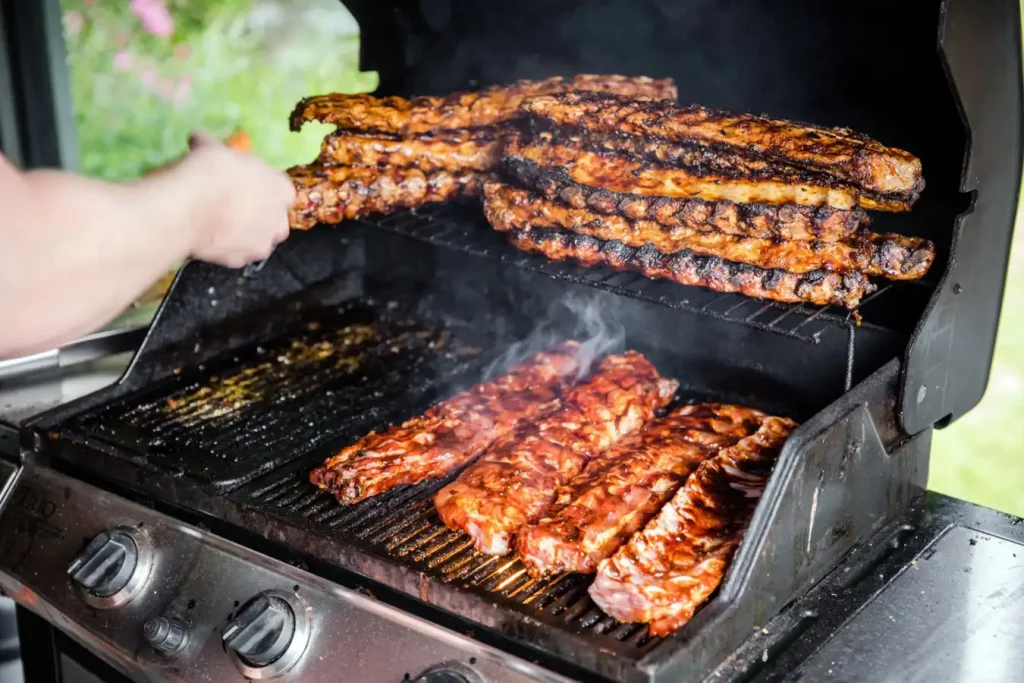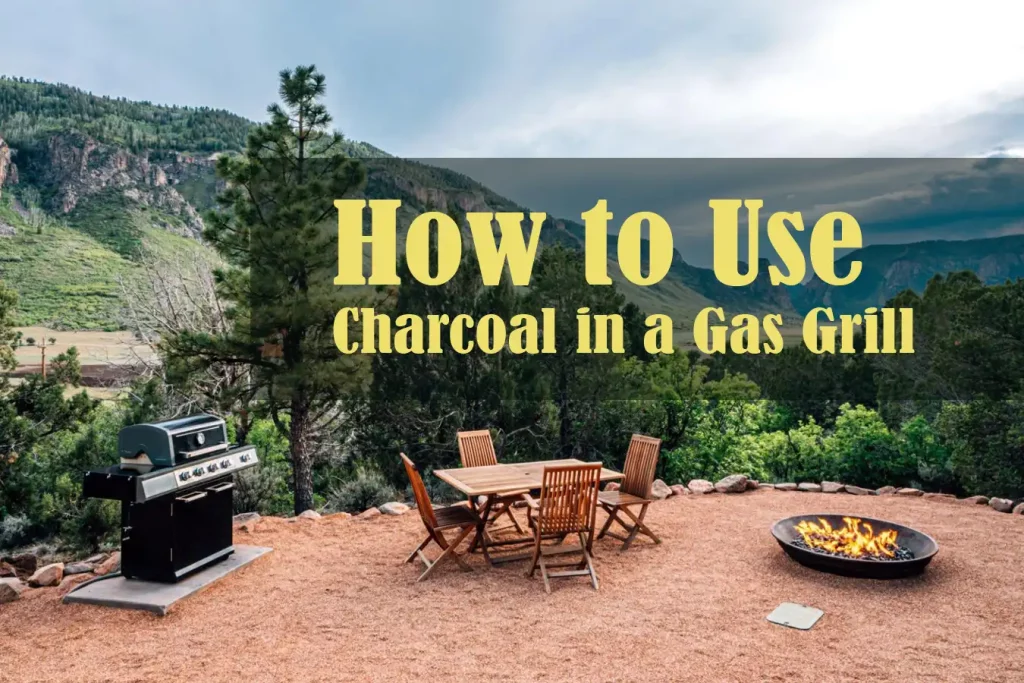Are you wondering how to use charcoal in a gas grill to truly savor the smoky flavor in your barbeque?
This article is your comprehensive guide.
As a passionate outdoor enthusiast and blogger, I understand the incomparable charm of campfire smoke and food.
Now, let’s bring that camping magic to your backyard.
Expect easy-to-follow steps and expert tips that will revolutionize your grilling game.
Get ready, fellow food adventurers, we’re about to light up your culinary world!
Understanding Gas Grills and Charcoal Grilling
Before we get into the heart of this culinary experiment, let’s take a moment to understand the essentials. Gas grills and charcoal grills, while they both serve the purpose of cooking your food, offer quite different experiences, flavors, and cooking techniques. By merging the two, you’ll experience the best of both worlds.

The Basic Mechanics of a Gas Grill
A gas grill, as the name suggests, uses propane or natural gas as a heat source. With a simple turn of a knob, you have an instant flame, and within minutes, your grill is heated to the desired temperature. One of the main advantages of a gas grill is its ease of use and precise temperature control. However, the flavor imparted by a gas grill is typically more neutral, often lacking the smoky depth that charcoal brings to the table.
The Allure of Charcoal Grilling
Charcoal grilling, on the other hand, is often associated with a more authentic grilling experience. The process is a bit more hands-on and requires you to light charcoal briquettes or lump charcoal, then wait for the coals to get hot. The reward for this additional effort? A smoky flavor that’s just not replicable with a gas grill. There’s something primal and satisfying about cooking over hot coals that gas grills often fail to emulate.
Preparation for Combining Gas and Charcoal Grilling
As the saying goes, “The secret to getting ahead is getting started”. The same applies to combining gas and charcoal grilling. There’s a bit of groundwork to be done before we can dive into the actual grilling process. So, let’s prepare ourselves to merge these two grilling worlds by understanding the required tools and essential safety considerations.
Essential Tools and Materials
To kick start this grilling experiment, you’ll need some basic tools:
- A gas grill: Needless to say, this is your main stage.
- Charcoal: You can choose between lump charcoal or briquettes based on your preference.
- A metal charcoal tray: This tray will hold the charcoal and allow you to place it over the gas burners.
- Heat-resistant gloves: Safety first!
- Long-handled tongs: To manipulate the charcoal.
- A grill brush: For cleaning purposes.
- A reliable lighter or matches: For lighting up the charcoal.
Safety Considerations When Mixing Gas and Charcoal
When you’re dealing with fire, safety is paramount.
- Always make sure your grill is on a flat, stable surface away from any flammable materials.
- Use heat-resistant gloves to prevent burns when handling hot items.
- Ensure your grill is clean to reduce the risk of flare-ups.
- Never leave a lit grill unattended.
To know more: How to Get More Smoke Flavor From Pellet Grill
Converting Your Gas Grill for Charcoal: A Step-by-Step Guide
Now that we’re armed with the knowledge and tools necessary, it’s time to get down to business. Here’s a step-by-step guide on how to convert your gas grill to charcoal and enjoy the best of both grilling worlds.
Step 1: Cleaning and Preparing Your Gas Grill
To start, you need to ensure your grill is clean. Use a grill brush to remove any residual food particles or grease build-up. Make sure the burners are turned off and the grill is cool before you begin. This is not only a safety measure but also helps in maintaining the longevity of your grill.
Step 2: Setting Up the Charcoal Tray
Next, place the metal charcoal tray on the grill grates above the burners. This tray will hold the charcoal and protect the burners. Ensure that the tray is sturdy and allows for good airflow. Spread an even layer of charcoal on the tray. The thickness of this layer can be adjusted depending on how much heat you want to generate.
Step 3: Lighting the Charcoal
Now comes the fun part, lighting the charcoal. You can do this by turning on the burners below the charcoal tray for a few minutes. Once you see the charcoal starting to glow, turn off the gas. Be careful during this process and keep a safe distance to avoid any accidental burns.
Step 4: Adjusting for Temperature and Smoke Control
Once your charcoal is lit, allow it to heat up. You can control the temperature by adjusting the amount of charcoal used and managing the grill’s vents if available. Remember, charcoal grilling often requires patience, so don’t rush the process. Allow the smoke from the charcoal to permeate your food, infusing it with that irresistible smoky flavor.
In short, to use charcoal in a gas grill, you need to place a charcoal tray or a disposable aluminum pan filled with charcoal over the burners, ignite your gas grill as usual to heat up the charcoal until it’s covered with a layer of ash, then turn off the gas, and cook your food over the heated charcoal for that authentic smoky flavor.
By following these steps, you can successfully combine the convenience of gas grilling with the flavorful punch of charcoal.
Learn more: How to Cook Shrimp on the Grill Without Skewers
Grilling Techniques for a Charcoal-Gas Combination
With the gas grill successfully converted for charcoal use, we now step into the exciting realm of grilling techniques. Balancing heat levels, using direct and indirect grilling methods, and mastering the art of infusing smoky flavor all come into play. So, let’s roll up our sleeves and dive right in!
Adjusting for Heat and Direct/Indirect Grilling Methods
One of the unique aspects of using charcoal in a gas grill is the ability to control heat levels effectively. For high-heat grilling, pile up more charcoal. For low-heat scenarios, spread out the charcoal evenly or pile it on one side to create a cooler zone.
Direct grilling, where food is placed directly over the heat source, is ideal for thin or small cuts of meat and vegetables. Indirect grilling, where food is set away from the heat and the grill lid is closed to trap heat, is perfect for larger cuts of meat that require longer cook times. Playing around with these methods can lead to some tasty results!
Tips for Achieving the Perfect Smoky Flavor
To achieve the perfect smoky flavor, patience is key. Allow your food to absorb the charcoal’s essence by maintaining a controlled, steady heat and resist the urge to continuously flip your food. If you’re feeling adventurous, consider adding flavored wood chips to the charcoal to infuse different smoky notes into your food.
Post-Grilling Procedures
Just like any good show, the grilling process also requires an appropriate curtain call. In this case, it involves properly extinguishing and disposing of the used charcoal and maintaining the grill for future use.
Properly Extinguishing and Disposing of Used Charcoal
Extinguishing the charcoal correctly is a safety imperative. Allow the charcoal to cool completely, then carefully dispose of it in a metal container. Never put hot or warm coals in a trash bin as it poses a fire hazard.
Cleaning and Maintenance Tips for Prolonged Grill Lifespan
A clean grill is a happy grill. After each use, ensure to clean the grates and the interior of the grill to prevent residue build-up. Regularly check for any signs of wear or tear and replace parts as needed. By following these maintenance practices, you can ensure your grill stays in top shape for many grilling seasons to come.
FAQs about Use Charcoal in a Gas Grill
Can You Put Charcoal in a Gas Grill?
Yes, you can use charcoal in a gas grill, but it requires careful preparation, including thorough cleaning and setting up a suitable charcoal tray to protect the gas elements.
How Do I Make My Gas Grill Taste Like Charcoal?
To make your gas grill taste like charcoal, you can use a charcoal tray or smoker box in your gas grill to achieve that distinct smoky flavor usually associated with charcoal grilling.
Can I Use My Old Gas Grill with Charcoal?
Absolutely! With the right steps, your old gas grill can be converted to use charcoal, provided it is clean, well-maintained, and safe to use.
How Long Should You Let Charcoal Burn Before Putting Food on the Grill?
Charcoal should be let to burn until it's covered with a thin layer of white ash, which typically takes around 10-15 minutes, ensuring a consistent and optimal heat for grilling your food.
Final Words
Grilling is more than just a cooking method; it’s an art form that brings people together. And when you combine the convenience of a gas grill with the distinct flavor of charcoal grilling, you’ve got yourself a winning combo. But remember, like any art form, it requires practice, patience, and a bit of creativity.
So, what’s next? It’s time to gather your tools, fire up your grill, and start experimenting. The stage is set for your grilling adventures. Happy grilling!


